Exposure to Aluminum in Drinking Water and the Risk of Developing Alzheimer’s Disease: A Bibliometric Analysis and Systematic Evaluation
Abstract
1. Introduction
2. Materials and Methods
2.1. Data Collection
2.2. Analysis and Treatment of Scientific Information from the Collection
2.3. Search Items
3. Results
3.1. Results of the Bibliometric Analysis
3.2. Analysis and Treatment of Scientific Information with VOSviewer
3.3. Analysis and Treatment of Scientific Information with Bibliometrix
3.4. Results of the Systematic Analysis
4. Systematic Review Discussion
- Large-scale, long-term epidemiological studies with robust exposure assessment methods and standardized diagnostic criteria for AD to better characterize the nature and magnitude of the relationship between aluminum exposure and disease risk;
- Studies that examine the potential interactions and synergies between aluminum and other environmental and genetic risk factors for AD, as well as the possible differences in susceptibility and exposure across different populations and geographic regions;
- Experimental studies to elucidate the potential mechanisms by which aluminum may contribute to AD pathology, and to determine the relevance of these mechanisms to human exposure levels and disease risk;
- Research on the effectiveness and feasibility of different interventions and strategies to reduce aluminum exposure through drinking water, including regulatory measures, water treatment technologies, and public education and behavior change programs.
- The need for more consistent and standardized methods for assessing aluminum exposure through drinking water, including the use of biomarkers and the consideration of other potential sources of exposure (e.g., food, medications, occupational exposures);
- The need for better control of potential confounding factors in epidemiological studies, including age, gender, education, socioeconomic status, and other known risk factors for AD;
- The need for more comprehensive and integrative research approaches that consider the complex interplay between environmental exposures, genetic susceptibility, and other biological and social determinants of health;
- The need for more effective communication and translation of research findings to policy makers, public health practitioners, and the general public, to inform evidence-based decision making and to promote informed choice and behavior change.
5. Conclusions
- Large-scale, longitudinal studies with improved exposure assessment techniques;
- The investigation of potential gene–environment interactions;
- The elucidation of specific mechanisms by which low-level, chronic aluminum exposure might influence neurodegenerative processes;
- Consideration of co-exposures and confounding factors.
Author Contributions
Funding
Data Availability Statement
Acknowledgments
Conflicts of Interest
References
- Shcherbatykh, I.; Carpenter, D.O. The role of metals in the etiology of Alzheimer’s disease. J. Alzheimer’s Dis. 2007, 11, 191–205. [Google Scholar] [CrossRef]
- Scheltens, P.; de Strooper, B.; Kivipelto, M.; Holstege, H.; Chételat, G.; Teunissen, C.E.; Cummings, J.; van der Flier, W.M. Alzheimer’s disease. Lancet 2021, 397, 1577–1590. [Google Scholar] [CrossRef]
- Abbass, I.M.; Choi, D.; Wallick, C.; Assunção, S.S. Trends in Healthcare Resource Use Preceding Diagnosis of Alzheimer’s Disease Dementia. Int. J. Alzheimer’s Dis. 2023, 2023, 8154701. [Google Scholar] [CrossRef] [PubMed]
- Breijyeh, Z.; Karaman, R. Comprehensive Review on Alzheimer’s Disease: Causes and Treatment. Molecules 2020, 25, 5789. [Google Scholar] [CrossRef]
- Mandriota, S.J.; Sappino, A.-P. The postulated innocuity of lifetime exposure to aluminium should be reappraised. Front. Oncol. 2023, 13, 1159899. [Google Scholar] [CrossRef] [PubMed]
- Bonfiglio, R.; Scimeca, M.; Mauriello, A. The impact of aluminum exposure on human health. Arch. Toxicol. 2023, 97, 2997–2998. [Google Scholar] [CrossRef] [PubMed]
- Krewski, D.; Yokel, R.A.; Nieboer, E.; Borchelt, D.; Cohen, J.; Harry, J.; Kacew, S.; Lindsay, J.; Mahfouz, A.M.; Rondeau, V. Human health risk assessment for aluminium, aluminium oxide, and aluminium hydroxide. J. Toxicol. Environ. Health B Crit. Rev. 2007, 10 (Suppl. S1), 1–269. [Google Scholar] [CrossRef]
- Willhite, C.C.; Karyakina, N.A.; Yokel, R.A.; Yenugadhati, N.; Wisniewski, T.M.; Arnold, I.M.F.; Momoli, F.; Krewski, D. Systematic review of potential health risks posed by pharmaceutical, occupational and consumer exposures to metallic and nanoscale aluminum, aluminum oxides, aluminum hydroxide and its soluble salts. Crit. Rev. Toxicol. 2014, 44 (Suppl. S4), 1–80. [Google Scholar] [CrossRef]
- Exley, C.; Vickers, T. Elevated brain aluminium and early onset Alzheimer’s disease in an individual occupationally exposed to aluminium: A case report. J. Med. Case Rep. 2014, 8, 41. [Google Scholar] [CrossRef]
- Song, J. Animal Model of Aluminum-Induced Alzheimer’s Disease. In Neurotoxicity of Aluminum; Niu, Q., Ed.; Springer Nature: Singapore, 2023; pp. 123–138. ISBN 978-981-99-1591-0. [Google Scholar]
- Tomljenovic, L.; Shaw, C.A. Aluminum vaccine adjuvants: Are they safe? Curr. Med. Chem. 2011, 18, 2630–2637. [Google Scholar] [CrossRef]
- Walton, J.R. Aluminum involvement in the progression of Alzheimer’s disease. J. Alzheimer’s Dis. 2013, 35, 7–43. [Google Scholar] [CrossRef] [PubMed]
- Rondeau, V.; Jacqmin-Gadda, H.; Commenges, D.; Helmer, C.; Dartigues, J.-F. Aluminum and silica in drinking water and the risk of Alzheimer’s disease or cognitive decline: Findings from 15-year follow-up of the PAQUID cohort. Am. J. Epidemiol. 2009, 169, 489–496. [Google Scholar] [CrossRef] [PubMed]
- World Health Organization. Guidelines for Drinking-Water Quality: Fourth Edition Incorporating First Addendum, 4th ed + 1st add; World Health Organization: Geneva, Switzerland, 2017; ISBN 9789241549950. [Google Scholar]
- EPA 810/K-92-001; Secondary Drinking Water Standards: Guidance for Nuisance Chemicals. United States Environmental Protection Agency: Washington, DC, USA, 2024.
- Gauthier, E.; Fortier, I.; Courchesne, F.; Pepin, P.; Mortimer, J.; Gauvreau, D. Aluminum forms in drinking water and risk of Alzheimer’s disease. Environ. Res. 2000, 84, 234–246. [Google Scholar] [CrossRef] [PubMed]
- McLachlan, D.R.; Bergeron, C.; Smith, J.E.; Boomer, D.; Rifat, S.L. Risk for neuropathologically confirmed Alzheimer’s disease and residual aluminum in municipal drinking water employing weighted residential histories. Neurology 1996, 46, 401–405. [Google Scholar] [CrossRef]
- Jacqmin, H.; Commenges, D.; Letenneur, L.; Barberger-Gateau, P.; Dartigues, J.F. Components of drinking water and risk of cognitive impairment in the elderly. Am. J. Epidemiol. 1994, 139, 48–57. [Google Scholar] [CrossRef]
- Martyn, C.; Osmond, C.; Edwardson, J.; Barker, D.; Harris, E.; Lacey, R. Geographical Relation between Alzheimer’s Disease and Aluminium in Drinking Water. Lancet 1989, 333, 59–62. [Google Scholar] [CrossRef]
- Wettstein, A.; Aeppli, J.; Gautschi, K.; Peters, M. Failure to find a relationship between mnestic skills of octogenarians and aluminum in drinking water. Int. Arch. Occup. Environ. Health 1991, 63, 97–103. [Google Scholar] [CrossRef]
- Martyn, C.N. Aluminium and Alzheimer’s disease: An epidemiological approach. Environ. Geochem. Health 1990, 12, 169–171. [Google Scholar] [CrossRef]
- Gillette-Guyonnet, S.; Andrieu, S.; Nourhashemi, F.; de La Guéronnière, V.; Grandjean, H.; Vellas, B. Cognitive impairment and composition of drinking water in women: Findings of the EPIDOS Study. Am. J. Clin. Nutr. 2005, 81, 897–902. [Google Scholar] [CrossRef]
- Rondeau, V.; Commenges, D.; Jacqmin-Gadda, H.; Dartigues, J.F. Relation between aluminum concentrations in drinking water and Alzheimer’s disease: An 8-year follow-up study. Am. J. Epidemiol. 2000, 152, 59–66. [Google Scholar] [CrossRef]
- Derviş, H. Bibliometric Analysis using Bibliometrix an R Package. J. Scientometr. Res. 2020, 8, 156–160. [Google Scholar] [CrossRef]
- Hossain, M.; Karmakar, D.; Begum, S.N.; Ali, S.Y.; Patra, P.K. Recent trends in the analysis of trace elements in the field of environmental research: A review. Microchem. J. 2021, 165, 106086. [Google Scholar] [CrossRef]
- World Health Organization. Guidelines for Drinking-Water Quality, Fourth Edition Incorporating the First and Second Addenda; World Health Organization: Geneva, Switzerland, 2022; ISBN 978-92-4-004506-4. [Google Scholar]
- Filipoiu, D.C.; Bungau, S.G.; Endres, L.; Negru, P.A.; Bungau, A.F.; Pasca, B.; Radu, A.-F.; Tarce, A.G.; Bogdan, M.A.; Behl, T.; et al. Characterization of the Toxicological Impact of Heavy Metals on Human Health in Conjunction with Modern Analytical Methods. Toxics 2022, 10, 716. [Google Scholar] [CrossRef] [PubMed]
- Järup, L. Hazards of heavy metal contamination. Br. Med. Bull. 2003, 68, 167–182. [Google Scholar] [CrossRef] [PubMed]
- Dartigues, J.F. Dementia: Epidemiology, intervention and concept of care. Z. Gerontol. Geriatr. 1999, 32, 407–411. [Google Scholar] [CrossRef] [PubMed]
- Exley, C.; Esiri, M.M. Severe cerebral congophilic angiopathy coincident with increased brain aluminium in a resident of Camelford, Cornwall, UK. J. Neurol. Neurosurg. Psychiatry 2006, 77, 877–879. [Google Scholar] [CrossRef]
- Joshi, J.G.; Fleming, J.T.; Dhar, M.; Chauthaiwale, V. A novel ferritin heavy chain messenger ribonucleic acid in the human brain. J. Neurol. Sci. 1995, 134, 52–56. [Google Scholar] [CrossRef]
- Forbes, W.F.; Gentleman, J.F.; Maxwell, C.J. Concerning the role of aluminum in causing dementia. Exp. Gerontol. 1995, 30, 23–32. [Google Scholar] [CrossRef]
- Domingo, J.L.; Gomez, M.; Sanchez, D.J.; Llobet, J.M.; Corbella, J. Effect of various dietary constituents on gastrointestinal absorption of aluminum from drinking water and diet. Res. Commun. Chem. Pathol. Pharmacol. 1993, 79, 377–380. [Google Scholar]
- Singla, N.; Dhawan, D.K. Zinc modulates aluminium-induced oxidative stress and cellular injury in rat brain. Metallomics 2014, 6, 1941–1950. [Google Scholar] [CrossRef]
- Singla, N.; Dhawan, D.K. Zinc Improves Cognitive and Neuronal Dysfunction During Aluminium-Induced Neurodegeneration. Mol. Neurobiol. 2017, 54, 406–422. [Google Scholar] [CrossRef] [PubMed]
- Rosborg, I. (Ed.) Drinking Water Minerals and Mineral Balance; Springer International Publishing: Cham, Switzerland, 2015; ISBN 978-3-319-09592-9. [Google Scholar]
- Jacqmin-Gadda, H.; Commenges, D.; Letenneur, L.; Dartigues, J.-F. Silica and Aluminum in Drinking Water and Cognitive Impairment in the Elderly. Epidemiology 1996, 7, 281–285. [Google Scholar] [CrossRef] [PubMed]
- van Dyke, N.; Yenugadhati, N.; Birkett, N.J.; Lindsay, J.; Turner, M.C.; Willhite, C.C.; Krewski, D. Association between aluminum in drinking water and incident Alzheimer’s disease in the Canadian Study of Health and Aging cohort. Neurotoxicology 2021, 83, 157–165. [Google Scholar] [CrossRef] [PubMed]
- Ahmed, M.F.; Mokhtar, M.B.; Alam, L.; Mohamed, C.A.R.; Ta, G.C. Non-carcinogenic Health Risk Assessment of Aluminium Ingestion Via Drinking Water in Malaysia. Expo Health 2019, 11, 167–180. [Google Scholar] [CrossRef]
- Cabral Pinto, M.M.S.; Marinho-Reis, A.P.; Almeida, A.; Ordens, C.M.; Silva, M.M.V.G.; Freitas, S.; Simões, M.R.; Moreira, P.I.; Dinis, P.A.; Diniz, M.L.; et al. Human predisposition to cognitive impairment and its relation with environmental exposure to potentially toxic elements. Environ. Geochem. Health 2018, 40, 1767–1784. [Google Scholar] [CrossRef]
- Wang, Z.; Wei, X.; Yang, J.; Suo, J.; Chen, J.; Liu, X.; Zhao, X. Chronic exposure to aluminum and risk of Alzheimer’s disease: A meta-analysis. Neurosci. Lett. 2016, 610, 200–206. [Google Scholar] [CrossRef]
- Ferreira, P.C.; Tonani, K.A.d.A.; Julião, F.C.; Cupo, P.; Domingo, J.L.; Segura-Muñoz, S.I. Aluminum concentrations in water of elderly people’s houses and retirement homes and its relation with elderly health. Bull. Environ. Contam. Toxicol. 2009, 83, 565–569. [Google Scholar] [CrossRef]
- Molloy, D.W.; Standish, T.I.; Nieboer, E.; Turnbull, J.D.; Smith, S.D.; Dubois, S. Effects of acute exposure to aluminum on cognition in humans. J. Toxicol. Environ. Health A 2007, 70, 2011–2019. [Google Scholar] [CrossRef]
- Freitas, M.B.; Brilhante, O.M.; Almeida, L.M. Importância da análise de água para a saúde pública em duas regiões do Estado do Rio de Janeiro: Enfoque para coliformes fecais, nitrato e alumínio. Cad. Saude Publica 2001, 17, 651–660. [Google Scholar] [CrossRef]
- Martyn, C.N.; Coggon, D.N.; Inskip, H.; Lacey, R.F.; Young, W.F. Aluminum concentrations in drinking water and risk of Alzheimer’s disease. Epidemiology 1997, 8, 281–286. [Google Scholar] [CrossRef]
- Forbes, W.F.; McLachlan, D.R. Further thoughts on the aluminum-Alzheimer’s disease link. J. Epidemiol. Community Health 1996, 50, 401–403. [Google Scholar] [CrossRef] [PubMed]
- Frecker, M.F. Dementia in Newfoundland: Identification of a geographical isolate? J. Epidemiol. Community Health 1991, 45, 307–311. [Google Scholar] [CrossRef] [PubMed][Green Version]
- Houeland, T. Aluminium and Alzheimer’s disease: Is there a causal connection? Environ. Geochem. Health 1990, 12, 173–177. [Google Scholar] [CrossRef] [PubMed]
- Mold, M.; Linhart, C.; Gómez-Ramírez, J.; Villegas-Lanau, A.; Exley, C. Aluminum and Amyloid-β in Familial Alzheimer’s Disease. J. Alzheimer’s Dis. 2020, 73, 1627–1635. [Google Scholar] [CrossRef]
- Yumoto, S.; Kakimi, S.; Ohsaki, A.; Ishikawa, A. Demonstration of aluminum in amyloid fibers in the cores of senile plaques in the brains of patients with Alzheimer’s disease. J. Inorg. Biochem. 2009, 103, 1579–1584. [Google Scholar] [CrossRef]
- Lidsky, T.I. Is the Aluminum Hypothesis dead? J. Occup. Environ. Med. 2014, 56, S73–S79. [Google Scholar] [CrossRef]
- Echeverry, G.; Zapata, A.M.; Paéz, M.I.; Méndez, F.; Peña, M.R. Valoración del riesgo en salud para un grupo poblacional de la ciudad de Cali-Colombia por exposición a Pb, Cd, Hg, 2-4D y Diuron debido al consumo de agua potable y alimentos. Biomedica 2014, 35, 110–119. [Google Scholar] [CrossRef]
- Tchernitchin, A.N.; Gaete, L. Influencia de contaminantes ambientales en la gestación humana: Causante de patologías en el adulto. Rev. Chil. Pediatr. 2018, 89, 761–765. [Google Scholar] [CrossRef]
- Wang, X. Analysis on Risk Factors of Women in Alzheimer’s Disease. In Proceedings of the 2020 International Conference on Public Health and Data Science (ICPHDS), Guangzhou, China, 19–21 November 2020; IEEE: Piscataway, NJ, USA, 2020; pp. 338–341, ISBN 978-1-7281-8571-2. [Google Scholar]
- Torres-Lozada, P.; Arango-Vallejo, L.A.; Torres-López, W.A. Estimación de la producción de lodos en plantas convencionales de tratamiento de agua potable mediante modelos de predicción. Rev. UIS Ing. 2022, 21, 87–96. [Google Scholar] [CrossRef]
- Badaró, J.P.M.; Campos, V.P.; Da Rocha, F.O.C.; Santos, C.L. Multivariate analysis of the distribution and formation of trihalomethanes in treated water for human consumption. Food Chem. 2021, 365, 130469. [Google Scholar] [CrossRef]
- Pastrana-Pacho, A.; Solis-Silvan, R.; Ávila-Lázaro, I.; Laines-Canepa, J.R.; Sánchez-Díaz, B. Coagulación de aguas residuales mediante una mezcla de polvo de Crotalaria longirostrata y sulfato de aluminio. Rev. Tecnol. Marcha 2023, 36, 135–142. [Google Scholar] [CrossRef]
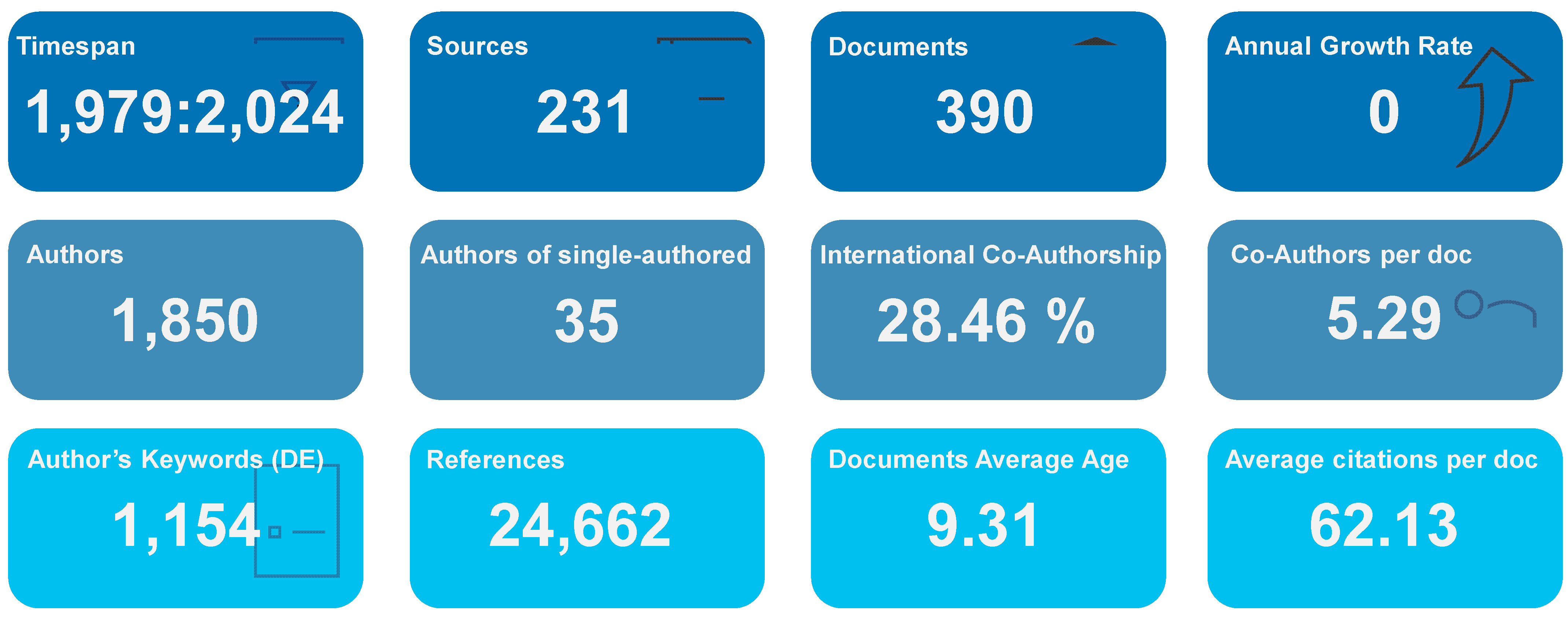
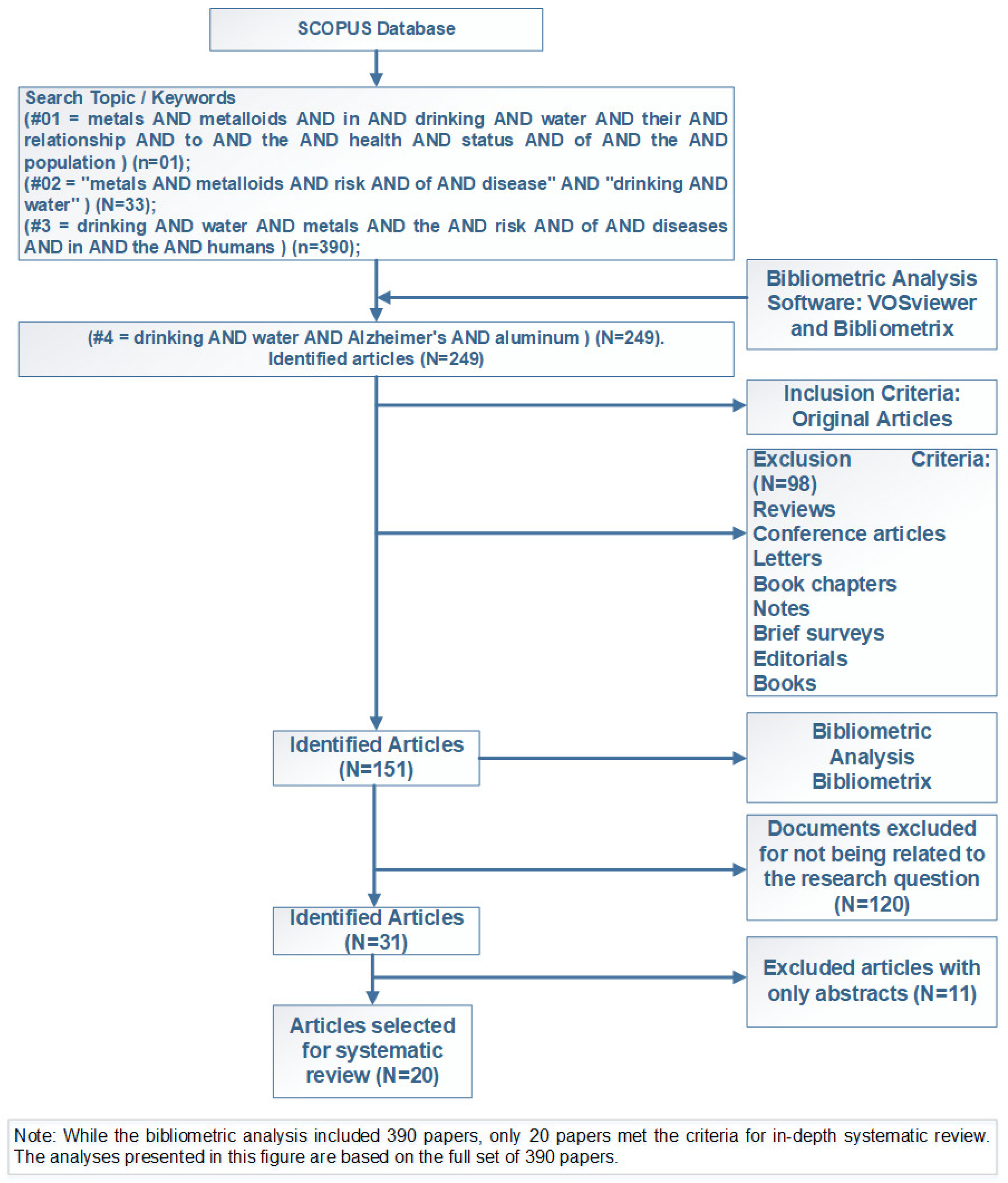

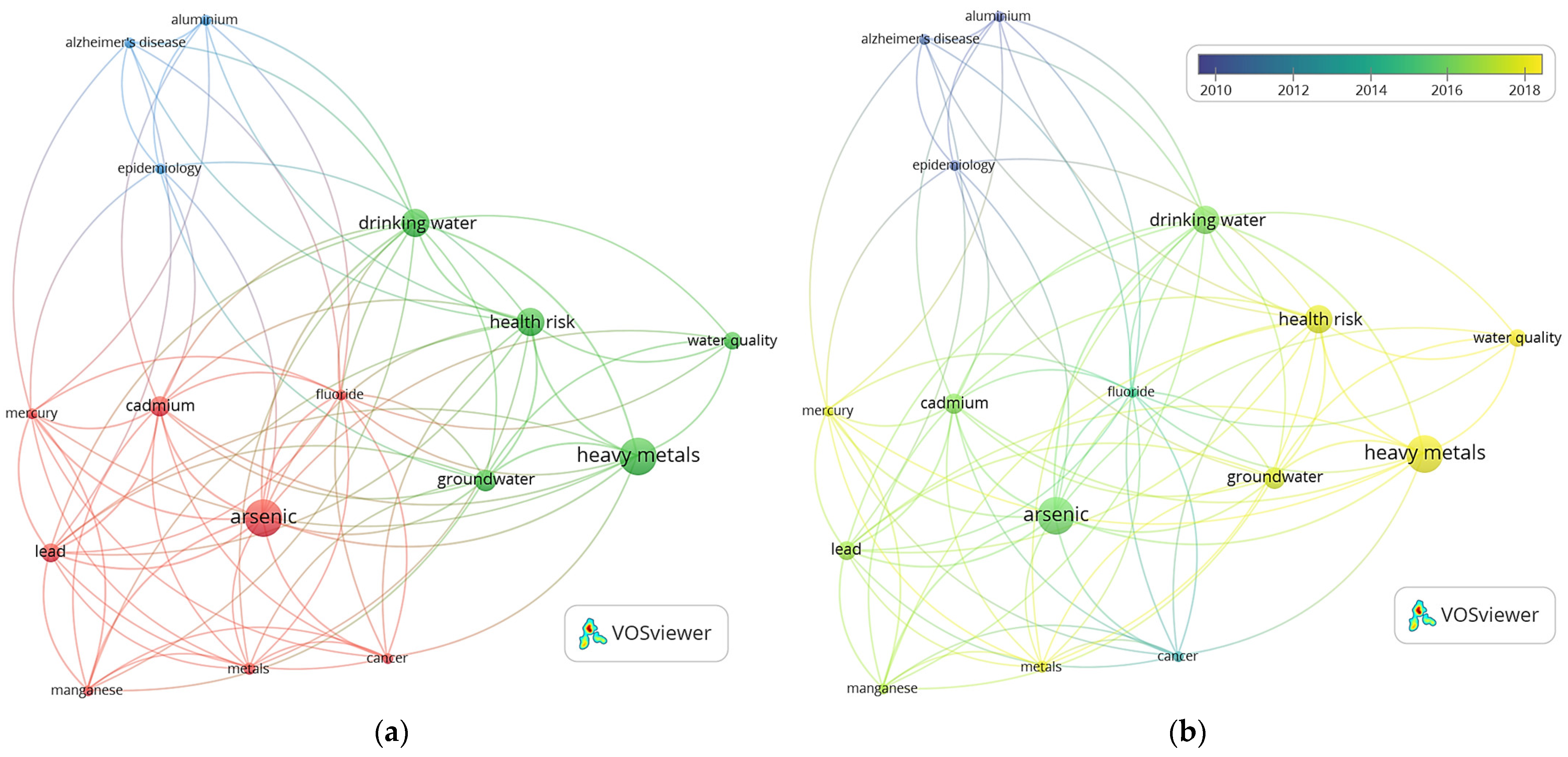
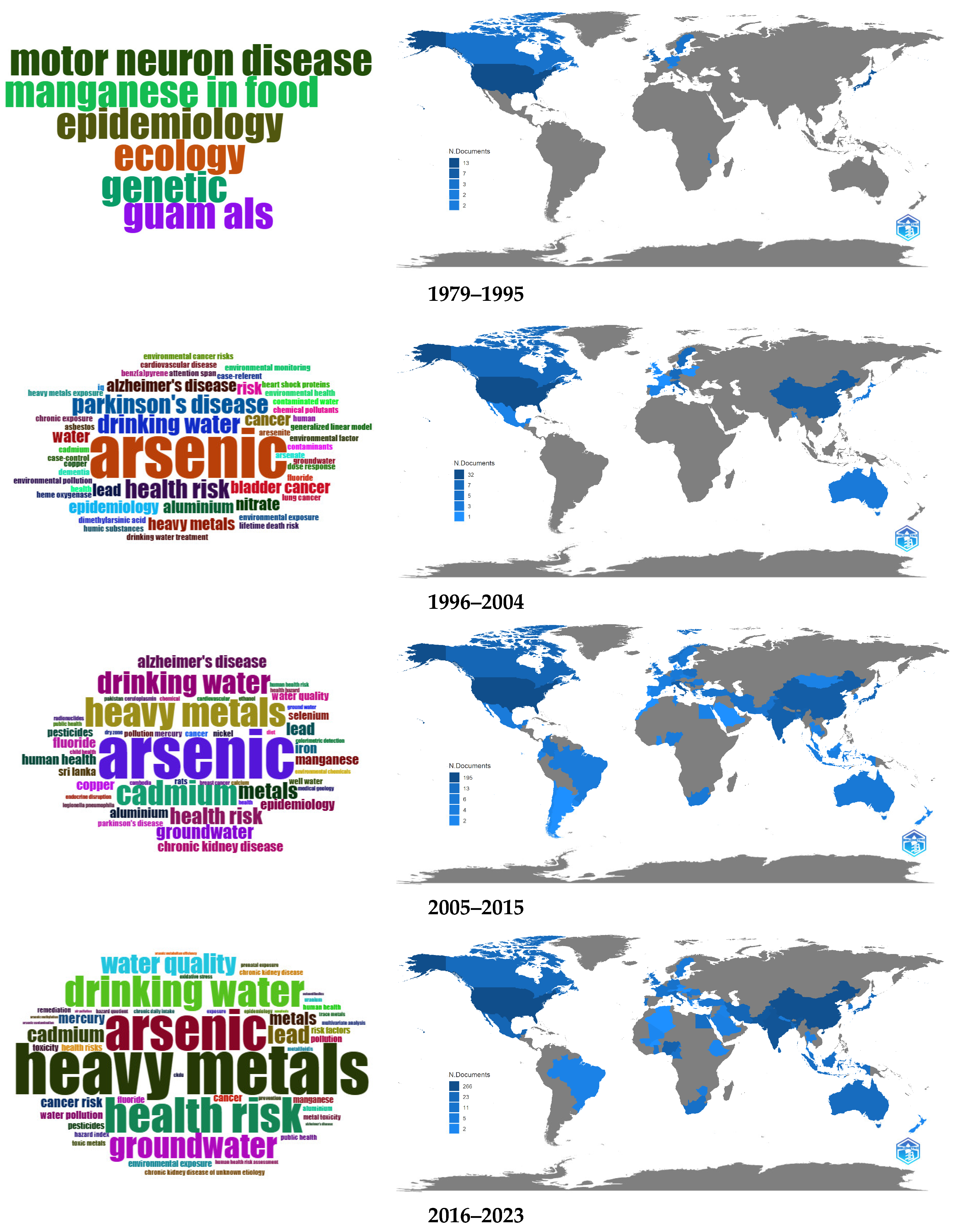
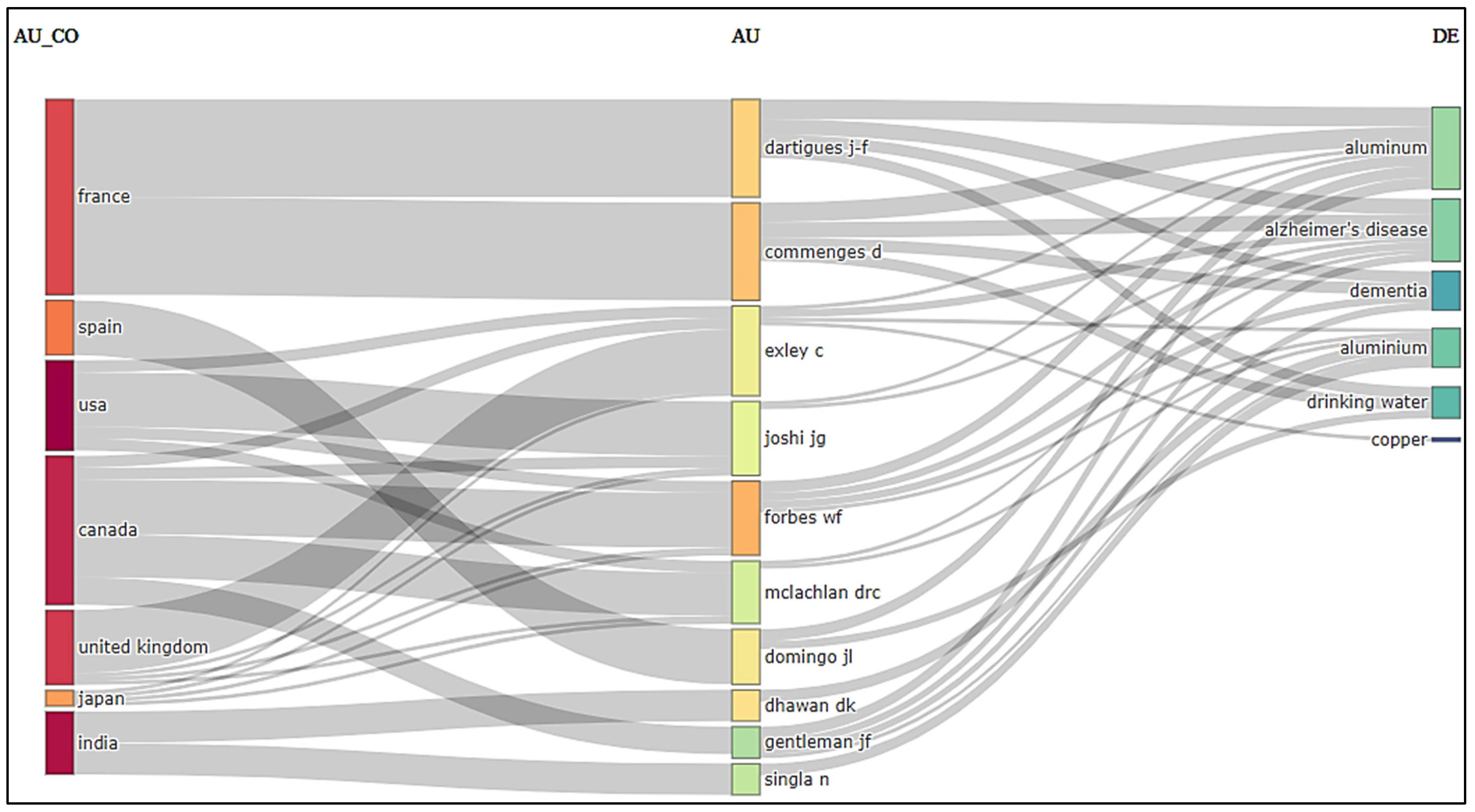
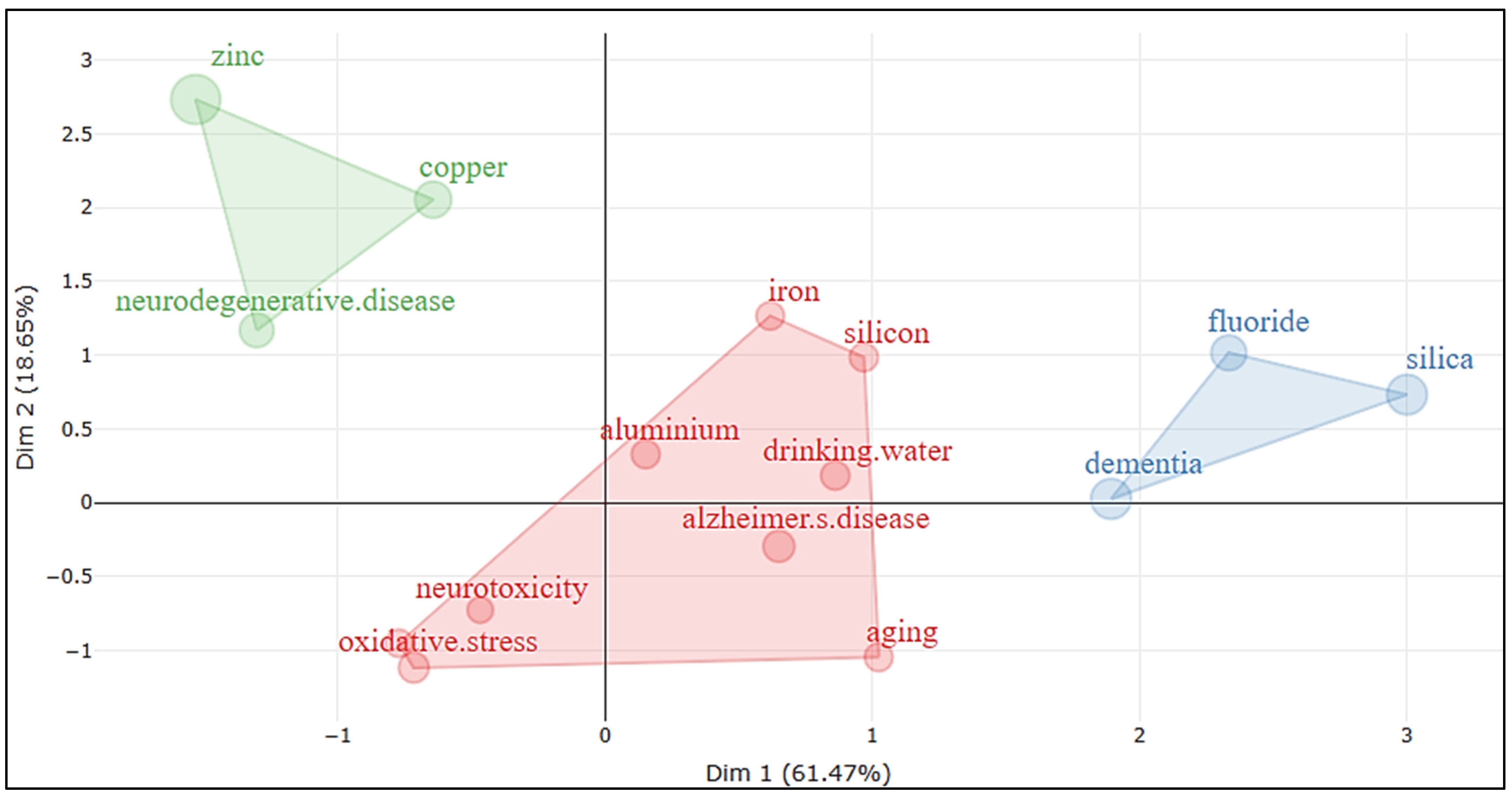

| N° | Journal | Quartile | Author | Year | Title | Country | Population Study | Methodology | Ref. |
|---|---|---|---|---|---|---|---|---|---|
| 1 | NeuroToxicology | Q2 | Van Dyke et al. | 2020 | Association between aluminum in drinking water and incident Alzheimer’s disease in the Canadian Study of Health and Aging cohort | Canada | Persons aged 65 years or older n = 10,263 | Analysis of Canadian Study of Health and Aging (CSHA) cohort | [38] |
| 2 | Exposure and Health | Q1 | Ahmed et al. | 2019 | Non-Carcinogenic Health Risk Assessment of Aluminium Ingestion via Drinking Water in Malaysia | Malaysia | 46 water samples 402 household surveys | Physical–chemical analysis. Health risk assessment | [39] |
| 3 | Environmental Geochemistry and Health | Q1 | Cabral Pinto et al. | 2017 | Human predisposition to cognitive impairment and its relation with environmental exposure to potentially toxic elements | Netherlands | 103 permanent residents of Estarreja city (>55 years) | Neuropsychological evaluation and urine/water analysis | [40] |
| 4 | Neuroscience Letters | Q2 | Wang et al. | 2016 | Chronic exposure to aluminum and risk of Alzheimer’s disease: A meta-analysis | China | 8 cohort and case–control studies (10,567 individuals) | Meta-analysis | [41] |
| 5 | Bulletin of Environmental Contamination and Toxicology | Q2 | Ferreira et al. | 2009 | Aluminum Concentrations in Water of Elderly People’s Houses and Retirement Homes and Its Relation with Elderly Health | Brazil | 46 water samples from kitchen taps | Atomic absorption spectrophotometry | [42] |
| 6 | American Journal of Epidemiology | Q1 | Rondeau et al. | 2008 | Aluminum and silica in drinking water and risk of Alzheimer’s disease or cognitive decline: Findings from 15-year follow-up of the PAQUID cohort | France | 1925 subjects free of dementia | PAQUID prospective cohort study | [13] |
| 7 | Journal of Toxicology and Environmental Health—Part A: Current Issues | Q3 | Molloy et al. | 2007 | Effects of Acute Exposure to Aluminum on Cognition in Humans | United Kingdom | 10 AD patients (76 ± 6 years) 16 men (54 ± 23 years) 21 women (55 ± 24 years) | Neuropsychological tests and crossover placebo-controlled trial | [43] |
| 8 | American Journal of Clinical Nutrition | Q1 | Gillete-Guyonnet et al. | 2005 | Cognitive impairment and composition of drinking water in women: findings from the EPIDOS study | United States | 7598 women aged 75 years in 5 areas of France | Short Portable Mental Status Questionnaire (SPMSQ) | [22] |
| 9 | Cadernos de Saudé Pública | Q2 | Freitas et al. | 2001 | The importance of water analysis for public health in two regions of Rio de Janeiro State: a focus on fecal coliforms nitrate and aluminum | Brazil | 46 water samples | Sample analysis | [44] |
| 10 | American Journal of Epidemiology | Q1 | Rondeau et al. | 2000 | Relation between Aluminum Concentrations in Drinking Water and Alzheimer’s Disease: An 8-year Follow-up Study | France | 3777 people aged ≥65 years in 75 parishes | Home interview and standardized questionnaire | [23] |
| 11 | Environmental Research | Q1 | Gauthier et al. | 2000 | Aluminum forms in drinking water and risk of Alzheimer’s disease | United States | 68 residents aged ≥70 years in Saguenay-Lac-Saint-Jean region | Extrapolation of historical data and standard analytical protocols | [16] |
| 12 | Epidemiology | Q1 | Martyn et al. | 1997 | Aluminum Concentrations in Drinking Water and Risk of Alzheimer’s Disease | United States | 106 men with AD 99 men with other dementias 226 men with brain cancer 441 men with other nervous system diseases | Patient/family surveys and CT scan records | [45] |
| 13 | Neurology | Q1 | McLachlan et al. | 1996 | Risk for neuropathologically confirmed Alzheimer’s disease and residual aluminum in municipal drinking water employing weighted residential histories | Canada | 830 individuals at time of death in Ontario | Neuropathological series and Ontario Drinking Water Surveillance Program | [17] |
| 14 | Journal of Epidemiology and Community Health | Q1 | Forbes & McLachlan | 1996 | Further thoughts on the aluminum-Alzheimer’s disease link | United KingdomCanada | Deceased groups from Newcastle UK and Ontario Canada | Analysis of water quality data from Drinking Water Surveillance Program | [46] |
| 15 | American Journal of Epidemiology | Q1 | Jacqmin et al. | 1994 | Components of drinking water and risk of cognitive impairment in the elderly | United Kingdom | 3777 French men and women aged ≥65 years | Survey and logistic regression | [18] |
| 16 | International Archives of Occupational and Environmental Health | Q2 | Wettstein et al. | 1991 | Failure to find a relationship between mnestic skills of octogenarians and aluminum in drinking water | Switzerland | 800 residents aged 81–85 years | Measurement of dementia rates via interview and serum/urinary aluminum via atomic absorption spectrophotometry | [20] |
| 17 | Journal of Epidemiology and Community Health | Frecker | 1991 | Dementia in Newfoundland: identification of a geographical isolate? | United Kingdom | Newfoundland inhabitants who died in 1985–1986 aged >70 years | Statistical analysis | [47] | |
| 18 | Environmental Geochemistry and Health | Q1 | Martin | 1990 | Aluminium and Alzheimer’s disease: an epidemiological approach | Netherlands | Sample of 200 death certificates | Epidemiological method | [21] |
| 19 | Environmental Geochemistry and Health | Q1 | Houeland | 1990 | Aluminium and Alzheimer’s disease: is there a causal connection? | Netherlands | Autopsy of 25 AD patients and 25 controls aged 65–80 years Study of 100 living AD patients aged 65–80 years | Bradford Hill criteria | [48] |
| 20 | The Lancet | Q1 | Martyn et al. | 1989 | Geographical relation between Alzheimer’s disease and aluminium in drinking water | United Kingdom | Survey of 88 county districts in England and Wales | Surveys CT scan records and analytical methods for measuring aluminum concentration in water over 10 years | [19] |
Disclaimer/Publisher’s Note: The statements, opinions and data contained in all publications are solely those of the individual author(s) and contributor(s) and not of MDPI and/or the editor(s). MDPI and/or the editor(s) disclaim responsibility for any injury to people or property resulting from any ideas, methods, instructions or products referred to in the content. |
© 2024 by the authors. Licensee MDPI, Basel, Switzerland. This article is an open access article distributed under the terms and conditions of the Creative Commons Attribution (CC BY) license (https://creativecommons.org/licenses/by/4.0/).
Share and Cite
Cutipa-Díaz, Y.M.; Huanacuni-Lupaca, C.; Limache-Sandoval, E.M.; Mamani-Huanca, D.Y.; Sánchez-Esquiche, W.M.; Rubira-Otarola, D.G.; Gutiérrez-Cueva, R.N.; Sacari Sacari, E.J. Exposure to Aluminum in Drinking Water and the Risk of Developing Alzheimer’s Disease: A Bibliometric Analysis and Systematic Evaluation. Water 2024, 16, 2386. https://doi.org/10.3390/w16172386
Cutipa-Díaz YM, Huanacuni-Lupaca C, Limache-Sandoval EM, Mamani-Huanca DY, Sánchez-Esquiche WM, Rubira-Otarola DG, Gutiérrez-Cueva RN, Sacari Sacari EJ. Exposure to Aluminum in Drinking Water and the Risk of Developing Alzheimer’s Disease: A Bibliometric Analysis and Systematic Evaluation. Water. 2024; 16(17):2386. https://doi.org/10.3390/w16172386
Chicago/Turabian StyleCutipa-Díaz, Yvonne Magali, César Huanacuni-Lupaca, Elmer Marcial Limache-Sandoval, Delia Yolanda Mamani-Huanca, Walter Mauricio Sánchez-Esquiche, David Gonzalo Rubira-Otarola, Roxana Nardy Gutiérrez-Cueva, and Elisban Juani Sacari Sacari. 2024. "Exposure to Aluminum in Drinking Water and the Risk of Developing Alzheimer’s Disease: A Bibliometric Analysis and Systematic Evaluation" Water 16, no. 17: 2386. https://doi.org/10.3390/w16172386
APA StyleCutipa-Díaz, Y. M., Huanacuni-Lupaca, C., Limache-Sandoval, E. M., Mamani-Huanca, D. Y., Sánchez-Esquiche, W. M., Rubira-Otarola, D. G., Gutiérrez-Cueva, R. N., & Sacari Sacari, E. J. (2024). Exposure to Aluminum in Drinking Water and the Risk of Developing Alzheimer’s Disease: A Bibliometric Analysis and Systematic Evaluation. Water, 16(17), 2386. https://doi.org/10.3390/w16172386





